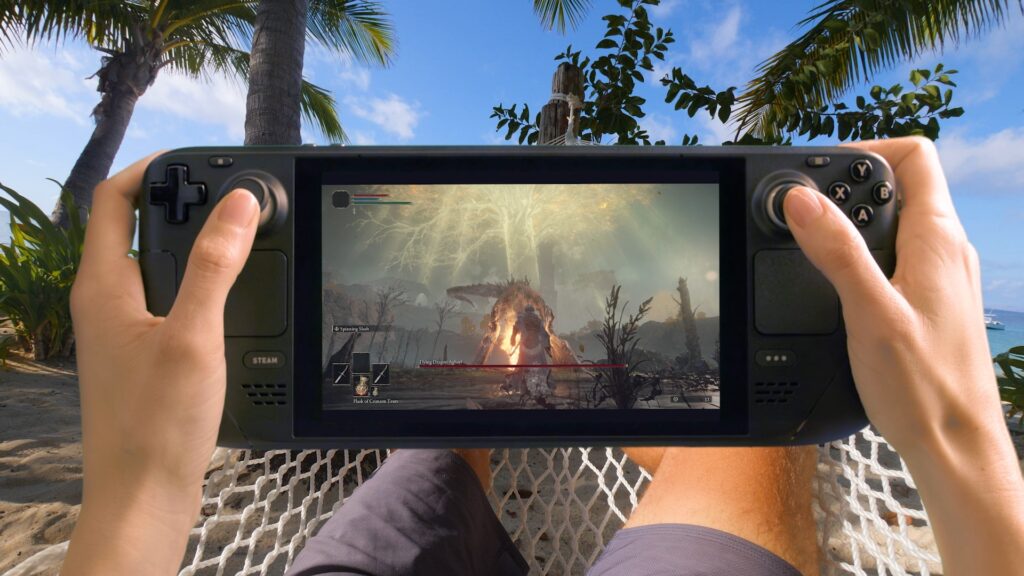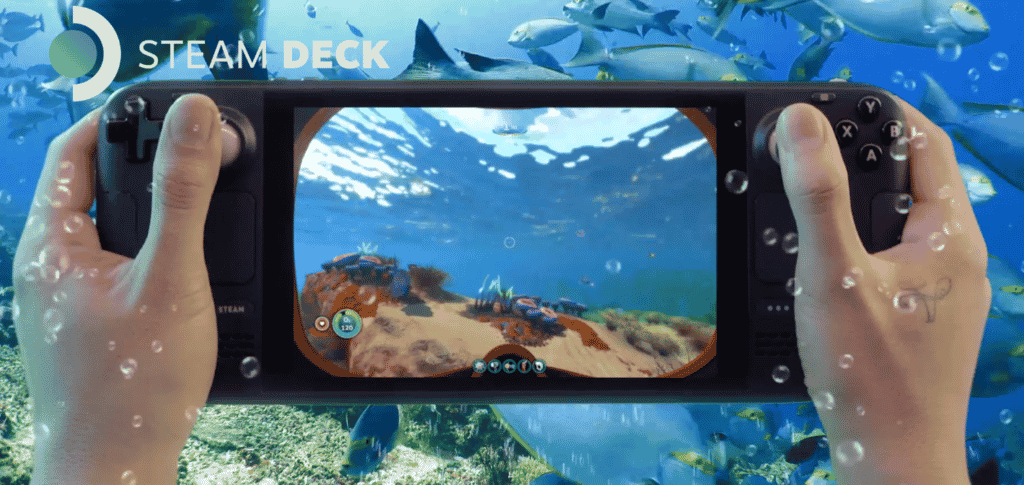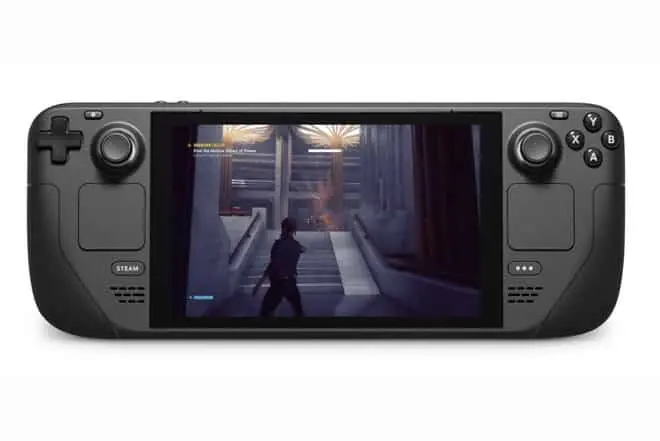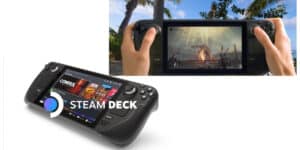The best portable console ever created is probably Valve’s Steam Deck, which retails for $399. Although it isn’t flawless, it outperforms devices like the PlayStation Vita and Nintendo Switch in terms of technology. It’s almost magical how such a small device can run Steam games. A technical wonder has indeed been revealed by Valve.
The Steam Deck is still somewhat of a work in progress, despite its advantages. Not every game in their Steam collection is playable, as well as the slight bit of controls are less accurate than I had sought. Insufficient battery life is another drawback. Future upgrades from Valve may (and probably will) take care of some of these problems. But this portable is still precisely what everyone wants, even in its present state.
What we will see here?
Specs at a glance:
- Zen 2 + RDNA 2 powerhouse
- Three versions : 64 GB , 256 GB and 512 GB
- 16 GB LPDDR5 on-board RAMÂ
- Controls:
- A B X Y buttons
- D-pad
- L & R analog triggers
- L & R bumpers
- View & Menu buttons
- 4 x assignable grip buttons
- 2 x full-size analog sticks with capacitive touch
- 1280 x 800px display
- 16:10 aspect ratio
- IPS LCDÂ display
- 400 nits typical brightness
- 60Hz refresh rate
- ambient light sensor
- Bluetooth 5.0Â support
- Wi-Fi- Dual-band Wi-Fi radio, 2.4GHz and 5GHz
- Dual microphone array
- 3.5mm stereo headphone/headset jack
- 45W USB Type-C PD3.0 power supply
- 40Whr battery. 2 – 8 hours of gameplay
- OS – SteamOS 3.0 (Arch-based)
- KDE Plasma 5 interface
Price and Availability

There are three arrangements for the Valve Steam Deck. All three devices are the same, with the exception of various storage and display choices. Storage capacities range from 64 GB for $399 to 512 GB for $649. The latter model also includes a display made of etched anti-glare glass. A black travel case with the Steam Deck symbol on top is available with each arrangement. The carrying bag for the $649 item has a gray interior and also includes a cleaning cloth.
You can buy the Steam Deck right now only through the desktop or online versions of Steam. The pre-order procedure for the portable from 2021 is still applicable even if it is technically out of production. For $5, you can reserve the configuration of your choice; the remaining balance is due when Valve sends the product. Valve will inform you before that happens so you can verify and complete your transaction. Orders won’t start shipping until October 2022 (or later) at the time of this writing.
Display

The 7-inch, 1280 x 800 LCD display of the Steam Deck produces incredible game graphics. The SteamOS UI can be accessed easily with a 16:10 aspect ratio. However, as many contemporary games have a 16:9 aspect ratio, you’ll lose some space around the outside of the game screen.
You will discover that the display’s average brightness was 169.7 nits. Both 68.5 percent of the sRGB color spectrum and 48 percent of the DCI-P3 color gamut are produced by this device. The latter values are below the target and it has an objective of 100% or more. The screen isn’t particularly brilliant numerically. But for actual use, as long as you’re inside, it’s bright enough. If you intend to play outside, you should stay in an area where there is some shade. Regarding how well the edition is, with the anti-glare screen performing outside, you will be unable to comment.
Images are clear, but the wide bezels that surround the screen are quite ugly. Additionally, I can’t help but question whether the device’s bezels might be smaller to allow for a bigger screen.
The size of the screen is enough for showing game visuals. However, whenever it relates to on-screen writing, that isn’t always the case. Even though I have generally decent eyesight, I had to squint to see the little print in Command & Conquer and Cyberpunk 2077. This is because the in-game language in these games is optimized for monitors and televisions. Some games allow you to change the font size, but if it’s not an option, you’re out of luck.
Design of Steam Deck

The Steam Deck is among the biggest handhelds available, measuring 11.73 × 4.60 x 1.93 inches. The largest game you can play, for sure. The Steam Deck is often, especially in comparison to the Nintendo Switch, but while being obviously much larger. You will think it’s more like the Sega Game Gear. The device seems remarkably light although costing close to 1.5 pounds. With its large flat core and curved hand grips, the Steam Deck has a luxury appearance thanks to its high level of construction.
Including a D-pad on the left & X/Y/A/B controls on the right, there seem to be two analog sticks, two trackpads, and other controls on each side. Whereas the Steam, as well as Quick Reach buttons, allow you to access SteamOS, View and Menu act as Select and Pause, respectively, in games.
Between both the shoulder buttons are volume controls, a 3.5 mm headphone connector, a USB-C port, and a power button. On the underside of the Steam Deck, there are four customizable back buttons as well as an SD card reader. Under the Quick Access and Steam buttons, there are two speakers. Along the top, there are air vents as well.
The Steam Deck has a similar appearance to other handhelds, yet it still looks fantastic. The unit’s weight distribution and button spacing make it pleasant to use for long spans. It’s obvious that Valve gave the user experience a lot of care, going so far as to position the USB-C connector on top so you can conveniently play while it is still charging.
Software:

Steam Deck is run by SteamOS 3.0, an Arch Linux operating system with just a KDE Plasma 5 interface. The operating system supports Proton, a compliance layer that enables SteamOS, a Linux operating system, to run games thought up for Microsoft Windows. With all of that, Steam Deck can play a wide variety of games, albeit not every game is compatible with the portable.
Instead of a user interface resembling Steam’s Big Picture mode, Steam Deck makes use of a custom desktop client for Steam that works well with controller input. You won’t have any issue moving throughout its menus and submenus if you’re familiar with Steam’s UI. So, you will have access to your Steam library, friend list, downloads, and settings.
You can view your notifications and change settings like brightness, speaker level, and controller rumble by clicking the Quick Settings button. Additional performance choices include scaling filter, thermal power limit, frame rate restriction, and refresh rate. You may set up the Steam Deck in a variety of additional ways to function precisely how you want. Users who are tech-savvy will undoubtedly like the system’s extensive customization capabilities.
Heat and Battery life of Steam Deck

It should come as no surprise that now the portable can get hot at times given that the Steam Deck can run visually demanding games.
According to the studies, the underneath becomes as warm as 90 degrees Fahrenheit throughout, with a peak temperature of 109 degrees near the vents. Additionally, the screen is 90 degrees. Fortunately, the temperature won’t rise over a comfortable level while you play because the controls are kept far from any of the hotter areas.
The Steam Deck held up for 3 hours and 51 minutes. It lost power during the preliminary tests at the three-hour mark. In other words, the type of game you’re playing will affect how long your battery lasts. For instance, Sonic Mania is less taxing than Cyberpunk 2077. But I want that the battery life had been at least five hours.
The Steam Deck: Just another PC?
The Steam Store is used to buy and download games. Nevertheless, as the Steam Deck is a computer, you may install additional programs and operating systems.
What accomplishes a Steam Deck?
SteamOS, a Linux operating system that Valve has built and maintains, is the default operating system for the Steam Deck. With a Linux version, it can play practically any game without any problems. Naturally, after several years of advancement, the Linux gaming community is still far behind Windows.
Is it worth purchasing the Steam Deck?
The Steam Deck is great if you simply want to play portable Steam games. The Steam Deck is also worthwhile looking into if you’re ready to put in the effort to get your favorite emulators working on a portable. But if you’re anywhere in the middle, the system isn’t great.
Conclusion:
Since Valve has revealed it. All the viewers are anticipating the Steam Deck, and I’m impressed with how it turned out. The handheld’s precise weight and pleasant controller configuration make it a pleasure to play. With its 7-inch display and surprisingly powerful speakers, the games look stunning and sound great.
The Steam Deck comes close to being ideal for some users, but it is not suitable for everyone. Many games still can’t run on the handheld or aren’t suitable as of the time of writing. The touchscreen was a good addition for games without controller layouts, but I’m hoping that later upgrades will improve its accuracy. The trackpads are the same way. Fortunately, all of the issues with Steam Deck are software, which Valve might fix in the next releases.
You can’t go wrong with getting a Steam Deck if you’re a Steam user who wants to take your games on the go or if you want a more powerful portable than the Nintendo Switch. It takes a while to receive one, but the wait is well worth it.
Read More:
- Steam Link: A way to play games on your macOS!
- Top picks of steam deck games for valve’s handheld console!
- Black + Decker 8 Cup Food Processor: A user-friendly design!
- Lightwave Smart Heating – A Smart Switch to keep your house warm!
- Best Clothes Steamers in 2020- Which model to choose?
















